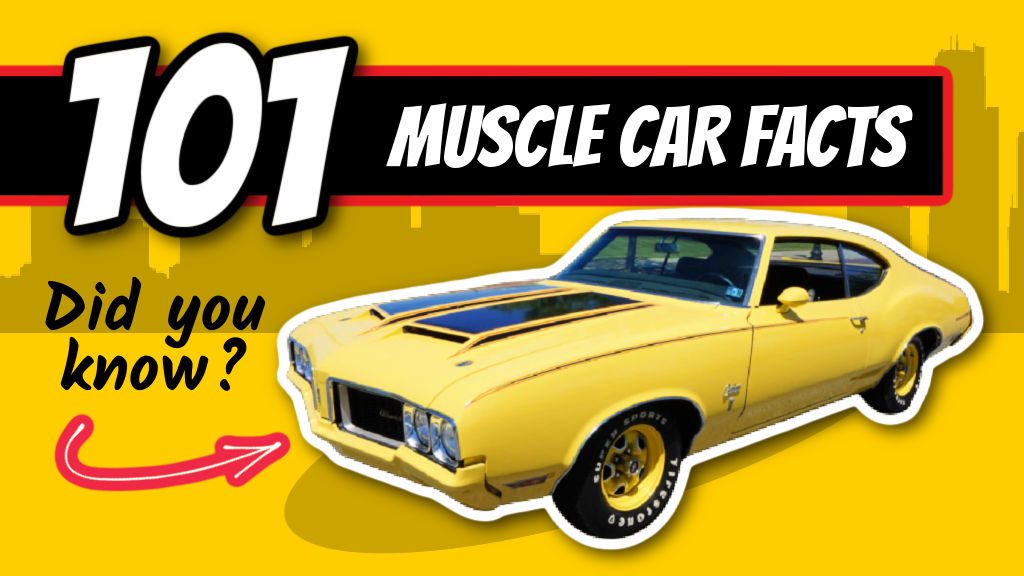
If you’re obsessed with classic American muscle cars and want to learn fascinating muscle car facts you can impress your friends with—you’re in the right place.
In today’s post, I will share 101 facts from the high-performance vehicles produced by American Motors Corporation, Buick, Chevrolet, Dodge, Ford, General Motors, Mercury, Oldsmobile, Plymouth, and Shelby from the years 1964-1974.
Taken from muscle car history, you’ll gain insights into production figures, quarter-mile times, pricing, terminology, paint colors, engine specs, and more on supercars to pace cars, pony cars to race cars, and everything in between.
Let’s take a closer look at 101 fascinating muscle car facts, shall we?
Table of Contents
Classic Muscle Car Facts
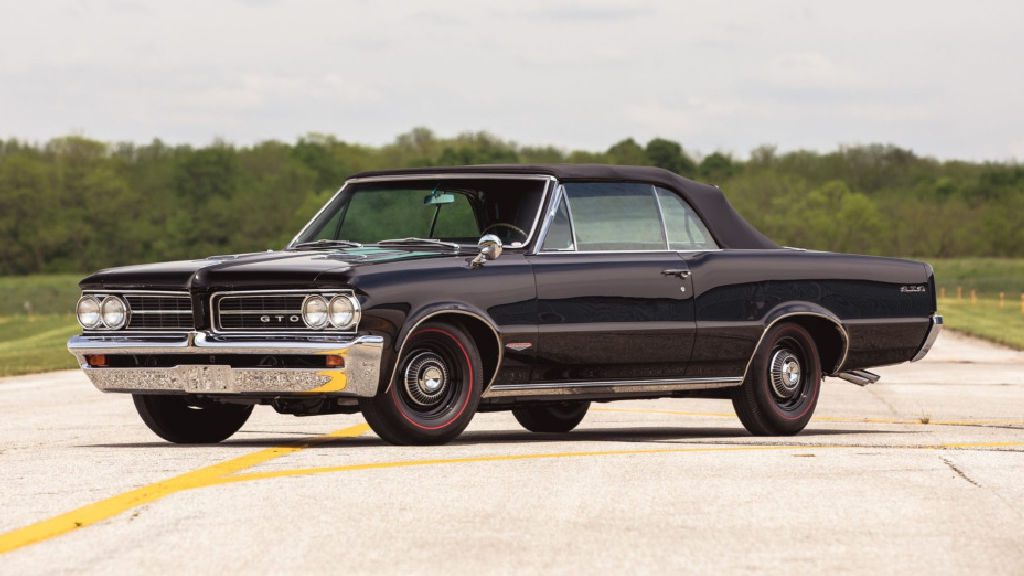
1. The original name for muscle cars in the 60s and 70s was “Supercars.”
2. The classic muscle car era lasted from 1964-1974. However, because the production of high-compression engines with high horsepower and torque ended in 1971, some would argue that’s when the golden era ended.
3. While American auto manufacturers are the originator of the muscle car movement, foreign muscle cars quickly spread to other countries, including Canada, Mexico, and Australia—with most coming from American-based parent companies.
4. The fastest recorded supercar is the 1969 Yenko Camaro 427 SYC, running a 12.59-second quarter-mile, traveling 108.2 miles per hour.
5. Toughening Federal emission standards, rising insurance premiums for supercars, and gas shortages created the perfect environment that ultimately ended the muscle car era.
AMC Muscle Car Facts
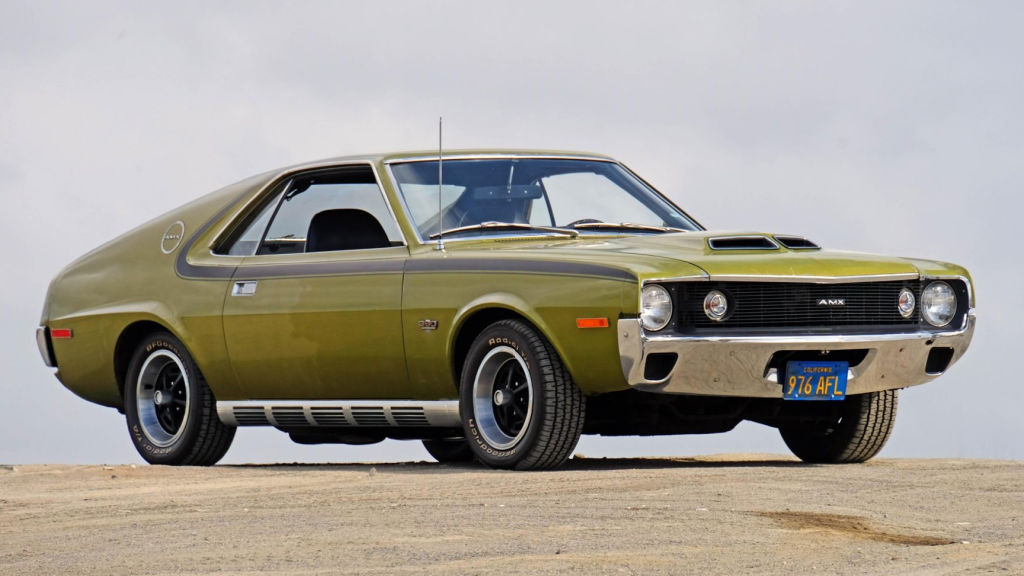
6. The “groovy” multi-color striped Pierre Cardin interior option was available on 4,561 Javelins and AMXs from 1972 to 1974.
7. In 1969, AMC introduced its version of Mopar’s high-impact paint options called “Big Bad” colors, including Big Bad Blue, Big Bad Green, and Big Bad Orange.
8. The 1969 AMC Hurst SS/AMX wasn’t street-legal. Instead, AMC built all 52 units for NHRA and AHRA drag racing competitions.
9. “The Rebel Machine” was an appearance and performance package on two AMC muscle cars, including the 1970 AMC Rebel (2,326 units) and 1971 AMC Matador (roughly 50 units) models.
10. The 1969 AMC Hurst SC/Rambler (1,502 units) was a one-year-only model that came in two red/white/blue paint schemes called “A” and “B.” The most popular version was the A scheme, with 1,002 produced.
11. The 1971 AMC Hornet SC/360 was another one-year-only model, ending production at 784 units. It is arguably one of the most underrated muscle cars of the era.
12. The 1970 AMC Trans-Am Javelin SST was built as a homologation special to compete in SCCA Trans-Am racing. Like many other AMC vehicles, it was painted in a patriotic Red/White/Blue paint color combination.
13. AMC produced 2,501 1970 Mark Donohue Javelins—surpassing the 2,500 homologation requirements by one unit—to use a new specialized “ducktail” rear decklid spoiler and functional ram air system for use in SSCA racing.
14. In 1968, AMC introduced the two-seater sports car, the AMX, as a budget-friendly alternative to the Chevrolet Corvette. It switched to the Javelin model in 1971.
15. The first 1,000 1971 AMC Rebel Machines produced had a patriotic red, white, and blue paint scheme. After the initial run, Rebel Machines were available in any factory color.
Buick Muscle Car Facts
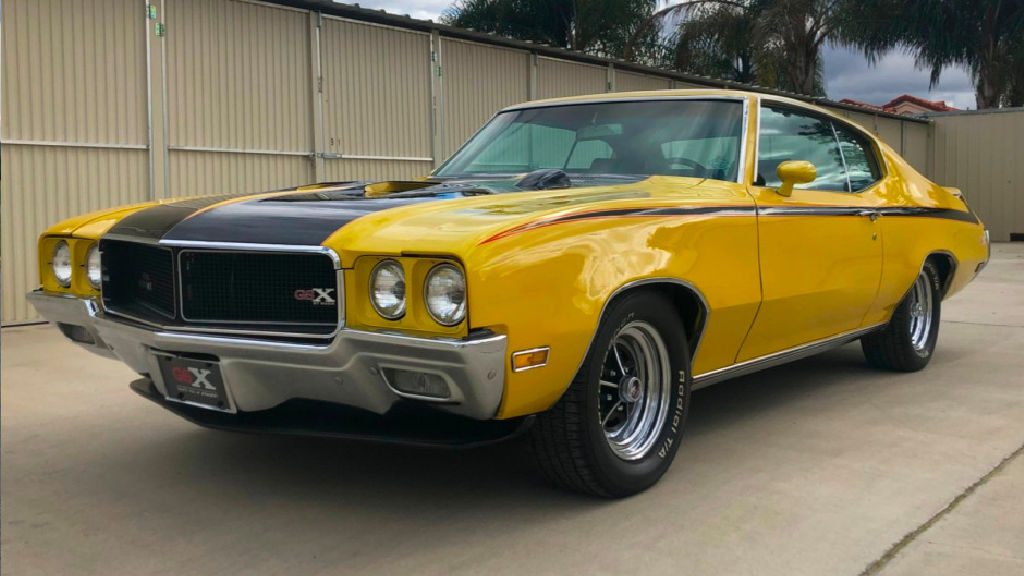
16. The 1970 GSX was one of the most powerful muscle cars and was Buick’s answer to the Pontiac GTO Judge, Oldsmobile 4-4-2 W-30, and Chevrolet Chevelle SS. However, the GSX started slowly, with only 678 built, making these 1970 muscle cars rare and desirable collectibles today.
17. In 1967, Buick introduced the “GS California” to California residents. The GS California was a budget-friendly junior muscle car with a 340 CID V-8, bench seat, and vinyl top. It could jog a quarter-mile in 16.7 seconds at 81 miles per hour.
18. The Stage 1 package started as a dealer-installed option in 1968, adding five horsepower to a stock GS400 (340 horsepower). However, it was seriously underrated, thanks to an aggressive camshaft and 11:1 compression. As a result, one could run a 14.4-second quarter-mile or 13.50 with slicks and headers.
19. The Stage 1 package in 1969 cost $199.95 ($1,487.38 today) and was the year it also became a proper factory option on GS400 hardtops and convertibles.
20. The Buick GS was released in the 1965 model year and stood for “Gran Sport.” It was one of the most luxurious and comfortable high-performance vehicles of its time—powered by a 401 CID V-8.
21. The 1971 Buick GS Stage 1 engine was rated at 345 horsepower with 460 lb-ft of torque and reached 801 Stage 1 Buick GS hardtops and 81 convertibles. The rarest of the bunch is the 4-speed convertible, with only nine examples produced.
22. The fastest muscle car in 1972 was the Buick GS 455 Stage 1, running a 14.10-second quarter-mile, traveling 97 miles per hour.
23. The Buick GSX ended in 1972 with only 44 units rolling off the assembly line, having 16 with a 350 CID V-8, 4 with a 455 CID V-8, and 24 with a Stage 1 455 CID V-8.
24. The 1973 Buick Gran Sport’s base 350 CID V-8 was the first GS to come with a 2-barrel carburetor. The Gran Sport also moved to an option package this year and was no longer a standalone model.
25. 1974 was when the 455 CID V-8 and Stage 1 455 CID V-8 ended in the Buick GS, with a new optional 2-barrel carburetor offered on the 455 before it departed.
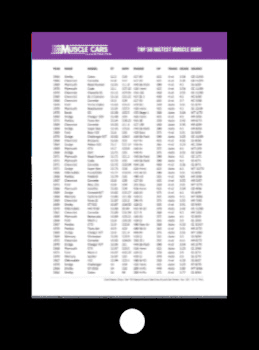
Get The Top 50 Fastest Muscle Cars chart. Includes year, model, engine, 1/4 mile times, and more—absolutely free!
Chevrolet Muscle Car Facts
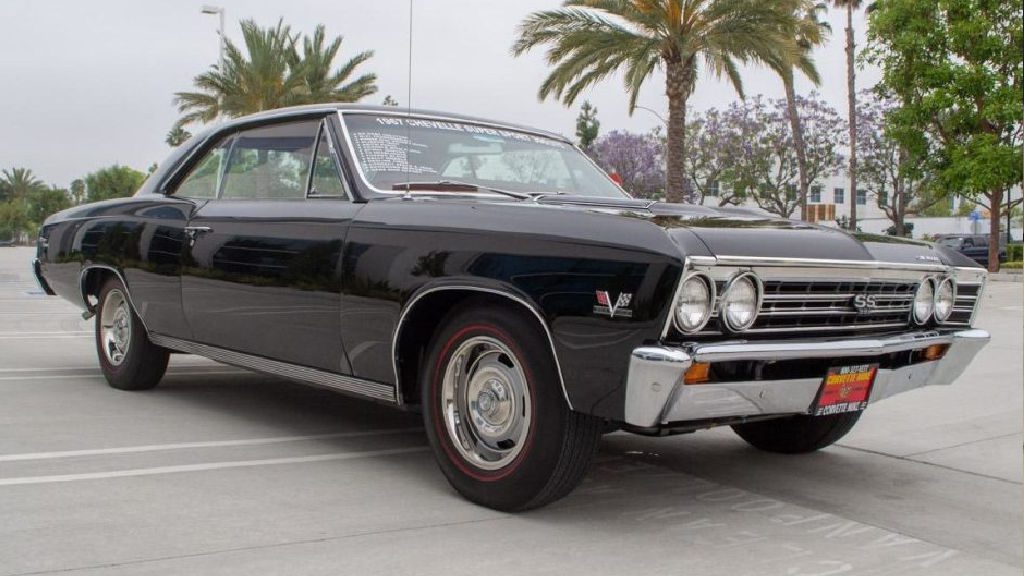
26. The highest advertised horsepower in a classic muscle car was the LS6 454 CID V8 at 450 horsepower—available in either the 1970 Chevelle SS or El Camino SS—and added $269 ($2,001.03 today) to the sticker price. The LS6-powered Chevelle SS was the third-fastest muscle car ever produced.
27. In 1969, Chevrolet could fit COPO Camaros with either an iron block L72 427 CID V-8 (425 horsepower) or a ZL-1 aluminum block 427 CID V-8 (430 horsepower). The L72 427 added $4,160.15 to the $2,272 base price of a garden variety V-8 Camaro.
28. The Camaro Z/28 first began production in 1967. The Z/28 option cost $358.35 ($2,665.68 today) and mandated a $184.35 ($1,371.34 today) M21 4-speed, $79 ($587.66 today) front disc brakes, and $42.15 ($313.54 today) power brakes.
29. Chevrolet’s pony car paced the Indianapolis 500 in 1967 and 1969. However, the 1969 Camaro stands out the most with its Dover White paint, Hugger Orange stripes, and Orange Houndstooth interior. Two official 396 CID V-8 versions were made, with 130 replicas used as festival and dignitary shuttle vehicles—many of which were 350 CID V-8/TH350 automatic transmission vehicles.
30. The 1970 Chevelle SS 396 was the highest-produced 1970 supercar, with 53,599 units rolling off the assembly line.
31. Chevrolet introduced the Heavy Chevy mid-year during the 1971 model year, ending it in 1972. Chevrolet targeted 20-somethings who were looking for performance on a budget. Chevy produced 6,727 Heavy Chevys in its debut year (1971) and 9,508 in its final year (1972).
32. Chevy manufactured 17,654 units of the 1969 Nova SS. Three engine options were available: the L48 350, L34 396, and L78 396 CID V-8. However, only 311 of them came with ultra-high-performance L89 aluminum heads.
33. The second fastest classic American muscle car in 1973 and 1974 was the Camaro Z/28, powered by a 350 CID V-8. In both cases, the Pontiac Firebird SD-455 overtook it for first-place honors.
34. In 1964, Chevrolet briefly introduced the L76 327 high-performance engine in the A-Body Chevelle to compete directly with its rival cousin, the Pontiac GTO. Chevy rated the Corvette-sourced L76 327 at 365 horsepower, installing it into at least one prototype. But, unfortunately, it never made it into regular production.
35. In 1968, the highest production Chevy muscle car was the Chevelle SS 396 at 62,785 units, while the lowest production was the Nova SS with 5,571 units rolling out of the factory.
Dodge Muscle Car Facts
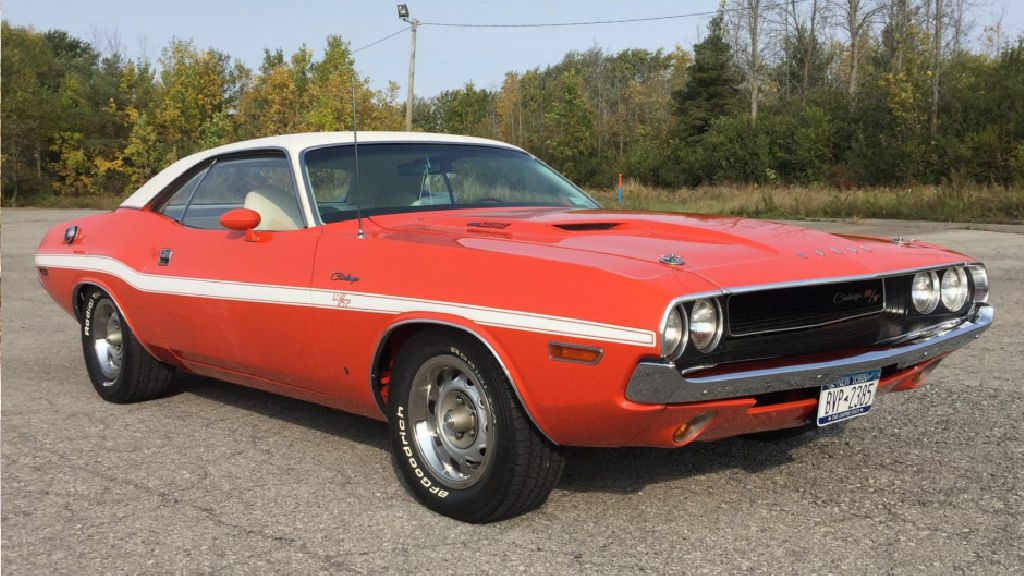
36. In the iconic feature film “Bullitt,” a 1968 Dodge Charger R/T chased Steve McQueen throughout downtown San Francisco, CA. The second-generation Charger kicked off that same year, with Dodge producing 17,584 Charger R/Ts.
37. The A12 440 Six Pack conversion package added $470 ($3,496.22 today) to a 1969 Dodge Super Bee sticker price. The Dodge Super Bee and Plymouth Road Runner were the only two automobiles with a fiberglass lift-off hood from the factory—sans hood hinges.
38. From 1969-1973, Dodge offered ten different vibrant paint color options called “High-Performance Colors,” including Hemi Orange, Plum Crazy, Bright Green, Go Mango, Butterscotch, Sublime, Green Go, Panther Pink, Citron Yellow, and Top Banana.
39. While built to dominate the NASCAR circuit in 1969, the 1969 Dodge Charger 500 never made it onto the oval track. Dodge produced an estimated 392 Charger 500s, roughly 108 short of 500 production unit homologation requirements. However, all was not lost. A 426 Hemi equipped Charger 500 became the fastest factory Dodge at the drag strip with a 13.48-second quarter-mile pass, traveling 109 miles per hour.
40. Dodge introduced the Demon in 1971 as an alternative to the Plymouth Duster for $2,721 ($18,341.76 today). However, it only lasted two model years. The Demon was available with a 340 CID V-8 as the highest-performance engine option, running a 14.89-second quarter-mile pass at 95 miles per hour.
41. Dodge developed the 1970 Challenger T/A for Trans Am racing. All 2,400 came standard with a 340 Six Pack engine, custom decals, rear decklid duck spoiler, side exiting exhaust, and a specialized fiberglass hood. The T/A stood for “Trans Am” and added $865.79 ($6,091.84 today) to the sticker price.
42. A Hemi 426 in any Mopar is extremely rare and valuable. However, when it came to 1970 Coronet R/Ts, only one convertible came with a 426 CID V-8 Hemi and was backed by a 4-speed manual transmission.
43. The 1969 Dodge Daytona was a one-year-only modified Charger 500 outfitted with an innovative air-splitting nose cone and rear spoiler, requiring 500 units to be made in regular production to qualify for NASCAR. Dodge beat the homologation requirements by just three vehicles, allowing one to reach a record-setting qualifying lap at 199.56 miles per hour.
44. The street 426 Hemi first appeared in Dodge’s 1966 model year, including a pair of four-door Coronet sedans, both backed with an automatic transmission. Dodge stuffed 1,521 426 Hemis into 738 different Coronets and 468 Chargers that year.
45. Dodge introduced the Scat Pack in 1968 as a brilliantly executed customer outreach program. Initially, the Scat Pack comprised the Charger R/T, Coronet R/T, Dart GTS, and Super Bee. Dodge muscle cars had to run a 14-second or less quarter-mile to qualify as a Scat Pack member. For only $3, members received a membership card, sticker, and patches to proudly display their loyalty to the “Pack,” as well as informative magazines, newsletters, and product guides to help keep them apprised of Dodge’s supercars and performance parts.
Ford Muscle Car Facts
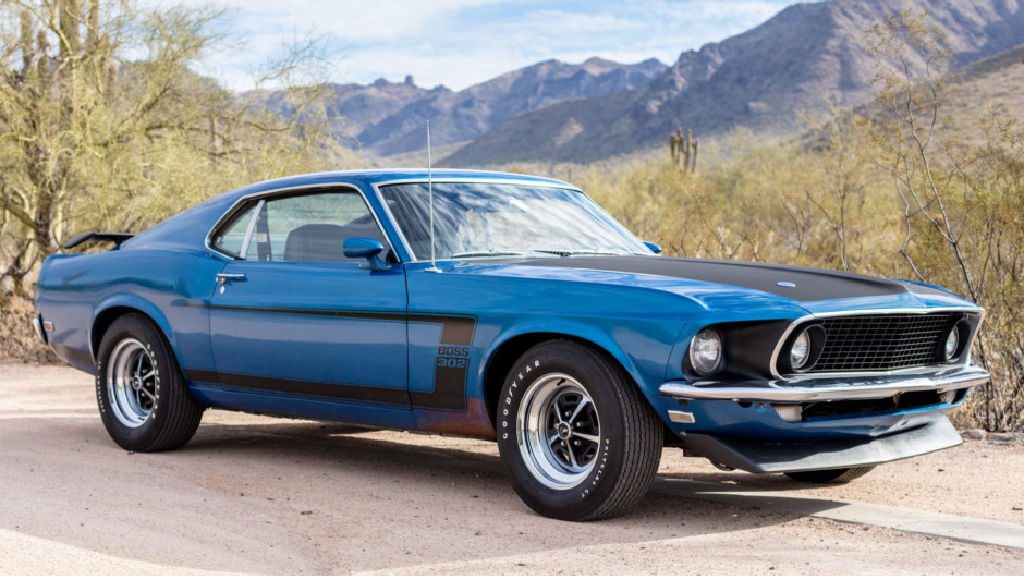
46. Ford is credited with inventing pony cars in 1964 with the release of its iconic Mustang. However, the 1964 Plymouth Barracuda technically beat it by two weeks and was no April Fool’s joke. The Barracuda was released on April 1, 1964, and the Ford Mustang on April 17, 1964. However, Ford stole the spotlight and has received the credit ever since.
47. The 1968 Mercury Cougar XR7-GT 428CJ was the fastest supercar in 1968, running a quarter-mile in 13.23 seconds at 103.4 miles per hour. Mercury’s Cougar also qualified as a pony car like the Ford Mustang.
48. Steve McQueen drove a Highland Green 1968 Ford Mustang GT fastback in the movie “Bullitt” during the epic car chase scene in downtown San Francisco, CA. It recently sold for $3.4 million at Mecum Auctions in Kissimmee, Florida.
49. The 1970 Ford Torino was Motor Trend’s Car of the Year. Ford made a total of 60,758 Torino GTs and 7,675 Torino Cobras that year.
50. John Wick’s car is a 1969 Ford Mustang Mach 1, not a 1970 Boss 429, as stated in the feature film John Wick: Chapter 1.
51. The Ford Torino 429SCJ was the fastest of its class in 1971, running a 13.30-second quarter-mile at 106 miles per hour.
52. In 1970, there were two 4-door Ford Falcon 429s produced. One was a 429 Cobra Jet, while the other was a 429 Super Cobra Jet.
53. The Boss Mustang was in limited production from 1969-1971. The lowest production numbers came from the 1970 Boss 429 with 499 units, while the highest came from 1970 Boss 302 at 7,013 units. In 1971, a Boss Mustang was only available with a 351 engine—with 1,806 rolling off the production line.
54. The fastest Boss Mustang was the 1970 Boss 429, dominating the quarter-mile with a 13.6-second pass, traveling 106 miles per hour.
55. Ford produced 745 1969 Talladegas, 245 more than necessary to qualify for NASCAR. Each came standard with a 428 Cobra Jet engine backed by C6 automatic transmission. Only three paint choices were available: Wimbledon White, Royal Maroon, and Presidential Blue. The Talladega dominated the track in 1969, winning 26 races compared to the runner-up Dodge with 22 victories.
Mercury Muscle Car Facts
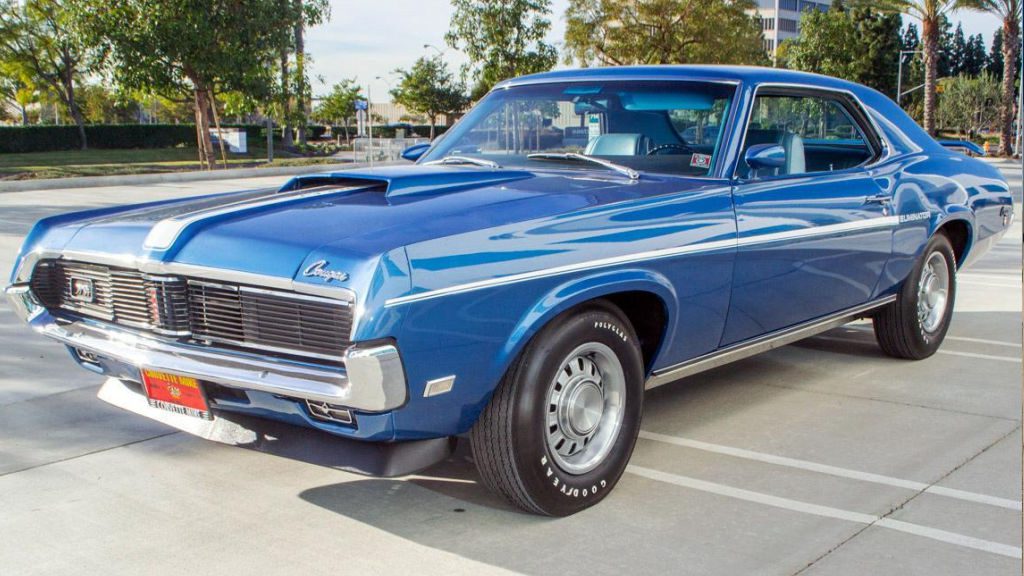
56. In its debut year, the 1967 Mercury Cougar was Motor Trend’s Car of the Year. Mercury produced 8,464 Cougar GTs and 19,783 Dan Gurney Specials that year.
57. The 1969 and 1970 Mercury Cougar Eliminator were the only vehicles besides the Boss Mustang to receive the Boss 302 engine from the factory. Mercury produced 169 of them in 1969 and 469 in 1970.
58. The Cyclone Spoiler II appeared mid-year in 1969 to honor Cale Yarborough and Dan Gurney, two legendary stock car drivers. The “Cale Yarborough Special” was red and white, while the “Dan Gurney Special” was blue and white.
59. The Montego-based 1970 Mercury Cyclone came in three variants: Base Fastback, GT, and Spoiler. A 370 horsepower ram air 429 Cobra Jet was the engine of choice in a Spoiler, the Cyclone’s top performance variant. But, if that wasn’t enough, a 429 Super Cobra Jet with 375 horsepower was also available.
60. Mercury introduced the 1969 Cyclone CJ, powered unsurprisingly by a 335 horsepower 428 Cobra Jet backed by a 4-speed manual transmission. A Cyclone CJ came standard with a competition handling package, low-restriction dual exhaust, and a blacked-out grille. In total, Mercury produced 3,261 Cyclone CJs—all fastback models.
61. Shelby wasn’t the only game in town when it came to collaborating with Hertz Rental Cars. Mercury struck a deal with Hertz to provide 188 of its 619 Cougar XR7-Gs in 1968. The Hertz XR7-G Cougar came standard with an S-code 6.7 liter/390 CID V-8 GT engine rated at 325 horsepower, 3-speed C6 automatic transmission, A/C, power steering, power disc brakes (front), tilt wheel, and custom gauges installed by Shelby. If it sounds like sending 619 vehicles to Shelby for some gauges seems like a lot of fuss, it wasn’t. Coincidentally, the XR7-G was made right on the same assembly line as 1968 Shelby Mustangs.
62. Introduced as a mid-year option in 1967, Mercury released 19,783 Cougar Dan Gurney Specials to pay tribute to the legendary stock car racer. However, Gurney had no input on the vehicle’s options. The Dan Gurney Special package added a sticker on the rear quarter window stating “Dan Gurney Special,” a chrome dress-up kit for the engine on the 289 CID V-8, F70x14 wide-oval whitewall tires, and “turbine” style wheel covers. Mercury built 5,166 hardtops and 2,673 XR7 hardtops.
63. The Indianapolis 500 selected the 1966 Comet Cyclone GT as its pace car for its 50th-anniversary event. Mercury produced 100 pace cars bearing a fiberglass twin scoop hood, featuring a 335 horsepower 390 CID V-8 and a 3-speed Merc-O-Matic automatic transmission.
64. Mercury dropped its distinctive Cougar Eliminator package for 1971 and refocused its efforts on a heavier Cougar XR7 and GT—both available with a 351 Cobra Jet (280 horsepower) or 429 Cobra Jet (370 horsepower)—the last year for a big block Cougar. While a courageous effort, the 429CJ equipped Cougar barely made the top 20 fastest of 1971, producing a 14.65-second quarter-mile at 98 miles per hour. Only 787 Cougar GTs came off the assembly line that year, signaling that the Mercury Cougar was losing its touch in the market.
65. The 1972 Mercury Montego GT isn’t something you hear much about—much less see at local car shows. However, Mercury produced 5,820 of these 4,000-pound intermediate fastbacks, equipped with V-8 engines ranging from a small block 302 to a big block 429.
Oldsmobile Muscle Car Facts
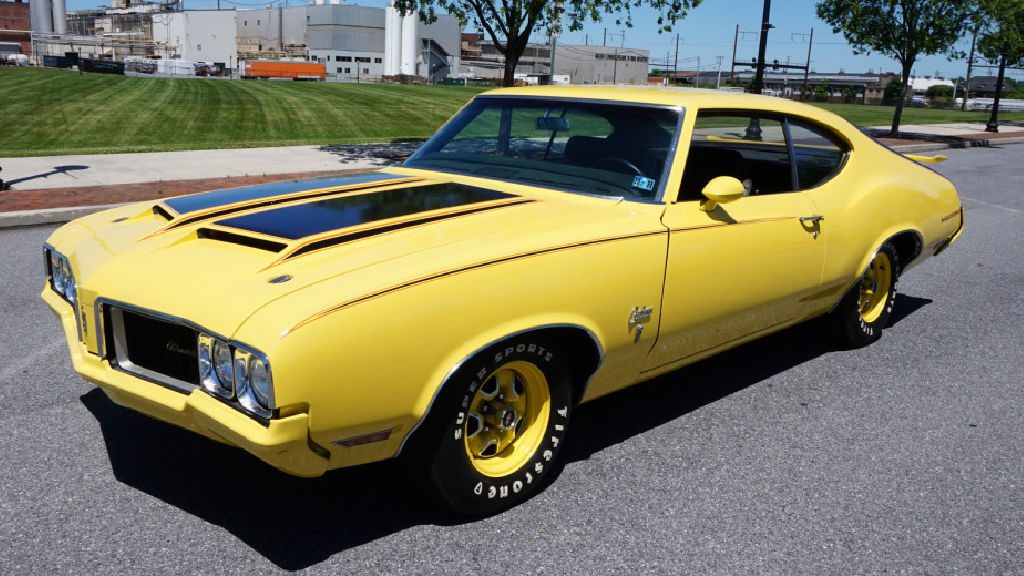
66. With its bold all-yellow color scheme, Oldsmobile intended the 1970 Oldsmobile Rallye 350 to catch the eye of young buyers. While Olds produced 3,547 Rallye 350s, sluggish sales forced dealers to get creative on how best to sell them. The most common complaint from potential buyers was that they were “too yellow.” It wasn’t uncommon for dealers to swap chrome bumpers, chrome trim rings, and a vinyl top to help reduce the yellow and move them off dealer lots.
67. Of the 914 Hurst/Olds convertibles produced in 1969, only three came in convertible form, one for east coast promotion, one for west coast promotion, and one for the 1969 Daytona 500. Two survived and are in the hands of private collectors. However, Olds reportedly destroyed the Daytona 500 version for unknown reasons.
68. The fastest vehicle in its class in 1966 was the Oldsmobile 442 W-30, ending Pontiac’s two-year streak with the 389 Tripower GTO.
69. The W-30 package on the 4-4-2 began in 1966 and ended in 1974. Initially available on 400-powered 4-4-2s, it switched to a 455 in 1970 after General Motors lifted its 400 cubic inch ban on mid-size models. The W-30 was an order code that added performance-enhancing features such as cold air induction and a hotter cam and is regarded as one of the best muscle cars.
70. The Hurst/Olds appeared in five of the eleven years during this time, including 1968, 1969, 1972, 1973, and 1974. The highest production figures transpired in 1974 (1,800), while the lowest came in 1968 (515).
71. In 1969, Oldsmobile offered four big-block options on its A-body platform: the Hurst/Olds, 4-4-2, 4-4-2 W-30, 4-4-2 W-32, and two W-31 small-block offerings: the Cutlass S or F-85. The W-30 (360 horsepower) and W-32 (350 horsepower) were both options on the 400 CID V-8, while the W-31 (325 horsepower) was available on the 350 CID V-8. All came standard with the dual-snorkel cold air induction package from the W-30.
72. While the 1970 Oldsmobile 4-4-2 convertible became the official pace car for the Indianapolis 500, Olds made Y-74 replicas on both the Cutlass and 4-4-2 convertible platforms. Y-74 production figures register 358 Cutlass convertibles and 268 4-4-2 convertibles. All 4-4-2s came with a 455 CID V-8, while 60 of the Cutlass vehicles had a 350 CID V-8. The W-30 package was not available on Y-74 vehicles.
73. Only 0.01 seconds and 0.01 miles per hour separated the 4-4-2 W-30 in 1970 and 1971 at the drag strip. 1970 W-30 posted a 13.89-second run at 101.1 miles per hour, while the 1971 version recorded a 13.90-second pass at 101.0 miles per hour.
74. The 1972 Oldsmobile 4-4-2 W-30 dropped to 8.5:1 compression with 300 horsepower and 410 lb-ft of torque. However, it was still the second-fastest in its class that year, pulling a 14.37-second pass, traveling 98 miles per hour—losing by just 0.27 seconds to the 1972 Buick GS 455 Stage 1.
75. Two significant changes occurred to the 4-4-2 in 1973, including discontinuing the 455 W-30 engine and 4-speed manual transmission from its lineup.
Plymouth Muscle Car Facts
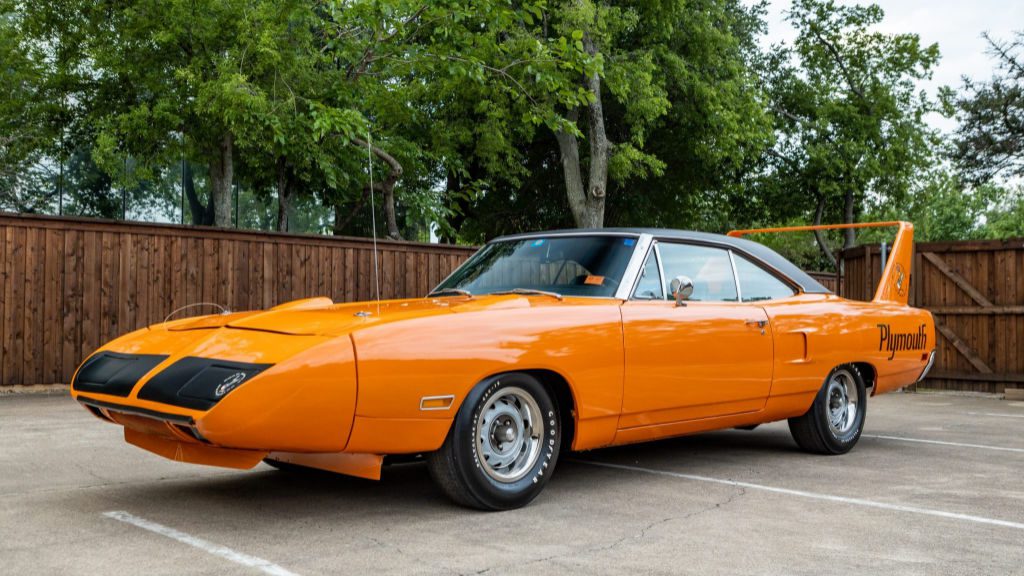
76. The fastest vehicle in 1970 was the Plymouth 426 Hemi Cuda, running a 13.10-second quarter-mile pass traveling at 107.1 Miles per hour. Plymouth made 666 Hemi Cudas in 1970, including 14 convertibles and 652 hardtops. A 426 CID V-8 Hemi added $871.45 ($6,482.52 today) to the sticker price.
77. From 1969-1973, Plymouth offered ten different vibrant paint color options called “High Impact Colors,” including Tor Red, In Violet, Lemon Twist, Bahama Yellow, Rallye Green, Vitamin C, LimeLight, Sassy Grass, Curious Yellow, and Moulin Rouge.
78. One year after its debut, the 1969 Plymouth Road Runner was Motor Trend’s Car of the Year—selling 79,693 vehicles in the United States that year.
79. The 1970 Plymouth Superbird could travel over 200 miles per hour on the NASCAR superspeedways, winning many races during the 1970 racing season. Plymouth assembled a total of 1,935 Superbirds, 1,084 with a 440 4v, 716 with a 440 6V, and 135 with a 426 Hemi 8V. All were hardtop models. Because so few were made, it has become one of the most popular muscle cars to clone.
80. The Rapid Transit System was Plymouth’s response to the Dodge Scat Pack—a very successful customer outreach program aimed at invigorating owners of Dodge vehicles. The ‘Cuda, GTX, Sport Fury GT, Road Runner, and 340 Duster comprised the Rapid Transit System in its inaugural 1970 sales brochure.
81. Plymouth introduced the 340 CID V-8 into the Plymouth Road Runner Mid-year in 1971—the first time a small block was ever available in the Road Runner. The 340 produced 275 horsepower and 340 lb-ft of torque.
82. Plymouth offered “Petty Blue” as a paint color option in the 60s and 70s, a non-metallic light shade of blue. The color’s name started as “Petty Blue” (1968-1970), then “Corporate Blue” (1971-1972), and then “Basin Street Blue” (1973). Petty Blue was a special order paint color code 9999 until 1972, when the paint code became TB3 and became a regular production paint color. No matter the year, most people call this color Petty Blue— named after Richard Petty’s favorite shade of blue on his racecars, including his #43 1970 Plymouth Superbird.
83. Due to lackluster sales, 1971 was the last year a GTX was available as a standalone model. So if you wanted a GTX from 1972 to 1974, you had to order a Road Runner with a 440 CID V-8, which automatically added GTX emblems (1972) or decals (1973-1974) to the vehicle.
84. The Plymouth Duster 340 outsold its controversially named Dodge Demon 340 cousin in 1971 and 1972 by nearly 8,000 units. Plymouth produced 10,478 Dusters in 1971 while Dodge produced 7,981 Demons. In 1972, Plymouth produced 15,681 Duster 340s versus 10,222 Dodge Demons. What’s in a name? In this case, it lost Dodge at least 7,956 sales.
85. High-performance vehicles were winding down in 1972, with higher insurance premiums, tightening federal emissions, and rising oil prices. As a result, Plymouth decided to disband the Rapid Transit System that year.
Pontiac Muscle Car Facts
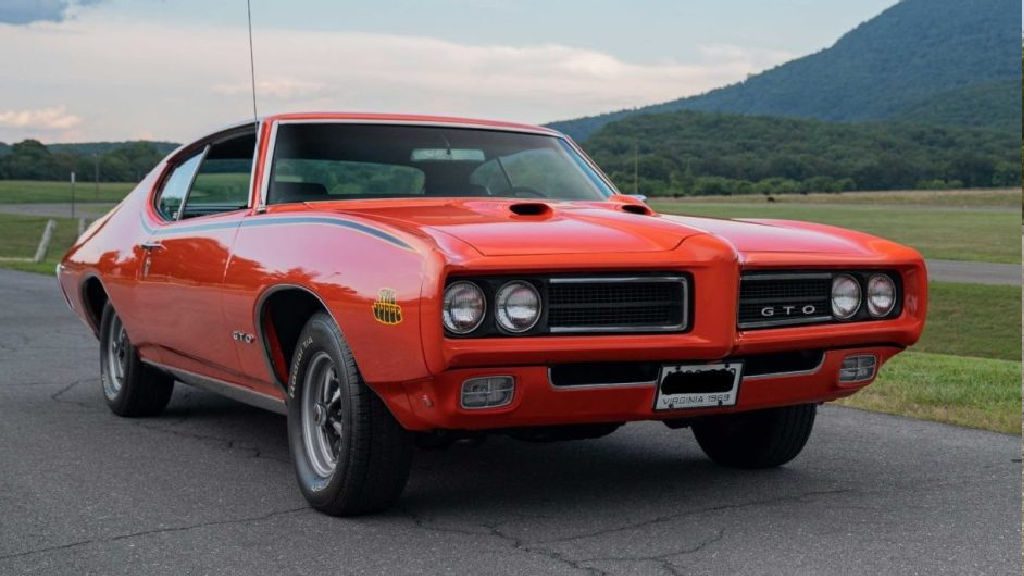
86. The first muscle car is a subject of debate, with some experts considering the 1949 Oldsmobile Rocket 88 as the pioneer, while others point to the 1964 Pontiac GTO. However, as the GTO was the car that kickstarted the muscle car era, it is often regarded as the first true muscle car. Its debut year sales of 32,450 units, with 8,245 featuring Tri-Power, set a benchmark for what a muscle car should be. Therefore, the GTO is credited with setting the standard for defining what a muscle car is.
87. The GTO package in 1964 added $295.90 ($2,201.13 today) to the base sticker price.
88. The 1968 Pontiac GTO was Motor Trend’s Car of the Year, with 87,864 happy buyers taking one home.
89. In 1969, the first 2,000 GTO Judges produced were all painted attention-getting Carousel Red. In total, 6,833 Judges were built this year, including 6,725 coupes and 108 convertibles.
90. The Pontiac GTO was the fastest production vehicle in 1964 and 1965, never returning to the top of the list.
91. At only eight units, the rarest 1969 Firebird Trans Am produced is the Ram Air III convertible.
92. The highest production model year for the GTO was 1966, with 96,946 units rolling off the production line.
93. Pontiac rolled out The Judge package in 1969 with 6,833 units. By the time it ended in 1971, PMD had made only 374 units. With only 17 produced, the rarest of them all was the 1971 GTO Judge convertible.
94. Pontiac produced some of the fastest classic muscle cars with book-ended victories at the beginning of the era, with the 389 Tripower GTO (1964 & 1965) and the Firebird SD-455 (1973 & 1974) at its end.
95. The radical Ram Air 400 III and IV engines started in 1969 and ended in 1970, with the 455HO overthrowing it in 1971. The advertised horsepower was 335 with 480 lb-ft of torque. The 1972 455HO produced 300 horsepower with 415 lb-ft of torque in its final year thanks to compression ratio drops mandated by Federal Emission Standards.
Shelby Muscle Car Facts
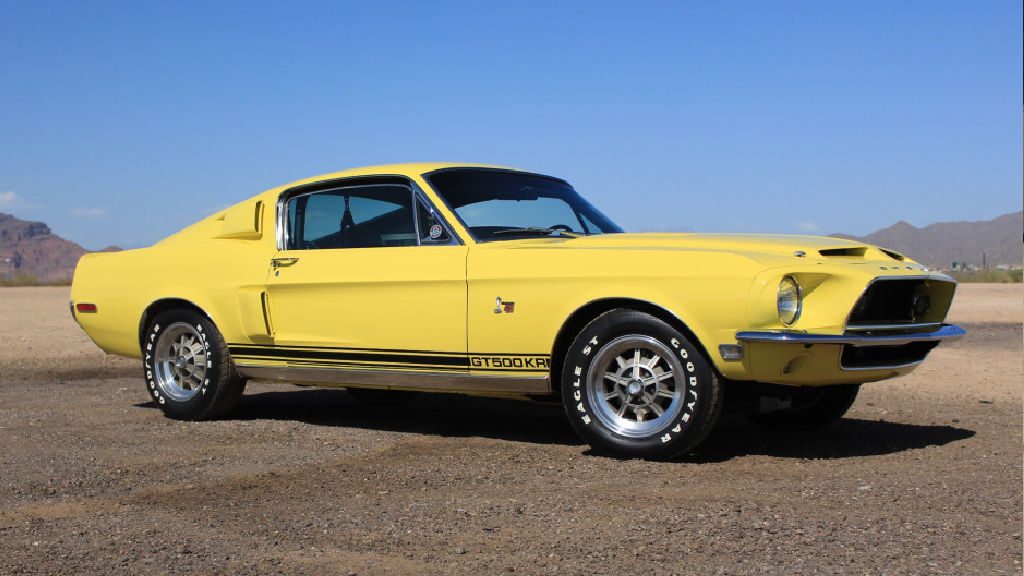
96. The rarest Shelby Mustang in 1969 was the single GT500 convertible built for Hertz Rental Company. Shelby dropped the KR reference because all GT500s came with a 428 Cobra Jet. A GT500 could run a quarter-mile pass in 13.87 seconds at 104.5 miles per hour.
97. The fastest recorded Shelby was the 1966 Shelby Cobra, powered by a 427 CID V-8 and backed by a 4-speed manual transmission and 3.54 rear gears. It ran a 12.2-second quarter-mile pass, traveling 118 miles per hour.
98. Shelby partnered with Hertz Car Rental in 1966 to produce 1,001 Shelby GT350H Hertz Rent-A-Racers, including two prototypes.
99. Shelby developed a one-of-one “Super Snake” GT500 in 1967, the first 427-equipped one of its kind. This ultra-rare Super Snake recently sold for $2.2 million at Mecum Auctions in Kissimmee, Florida.
100. Shelby was back at Hertz in 1968, producing three ultra-rare one-of-one specimens, including a GT350H convertible, a GT500H, and a GT500KR-H convertible.
101. Carroll Shelby broke off his contact with Ford Motor Company in the summer of 1969. However, Ford continued to produce the GT350s and GT500s without him. In 1970, Ford took all the unsold 1969 models and had new 1970 VINs created for them. They made only two cosmetic changes, including adding twin stripes on the hood and a front chin spoiler.
Well, there you have 101 muscle car facts from AMC, Chrysler, Ford, General Motors, and Shelby. Be sure to subscribe to see more content like this!

Ryan Wheaton
Ryan has owned muscle cars since 1986 and currently owns a 1972 Dodge Charger Rallye. He combines passion and experience to create engaging content for fellow muscle car enthusiasts. In 2018, he founded Muscle Cars Illustrated, authoring hundreds of articles on tips, history, and trends in the muscle car industry. He attends national car shows, auctions, and museums to stay current with the latest developments in the muscle car industry.
